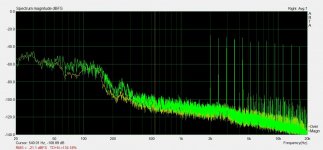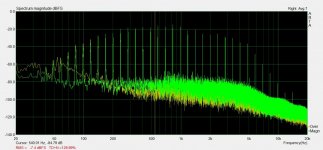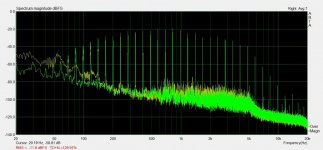I gave it some LF abuse for abt 30min before starting these tests, and now gave it a 'heavy massage' too, but there was no change in FR
I just stumbled over your project - not a regular writer here. But I also searched for the best 8" speaker for high power Homecinema - and I was not happy with the 18Sound. While it's a good driver for PA I wouldn't use it for lower level listening.
After testing A LOT of drivers I would recoomend PHL 2460 for your use.

After testing A LOT of drivers I would recoomend PHL 2460 for your use.
Thank you for your input, and that in an impressive amount of woofers! Did you write about it somewhere?
I relied on Troels test and opinion, and this is what I have now, so I at least have to make a serious attempt at using them before I go and buy something for a lot of money (again). Expenses on this project will be getting very high for my standards if I get a Minidsp Flex Eight to run full active XO..
I relied on Troels test and opinion, and this is what I have now, so I at least have to make a serious attempt at using them before I go and buy something for a lot of money (again). Expenses on this project will be getting very high for my standards if I get a Minidsp Flex Eight to run full active XO..
Last edited:
I decided to order the Minidsp flex eight, could only find one in stock in EU, and they are backordered according to the minidsp home page. Could have taken a long time to get one if I waited it seems.
A suggestion. On the rim of the mid where it overlaps the waveguide, add a ridge of something like play-dough, , say for some 10cm, and say 2 cm thick and wide.I'm thinking it's time to give up, and accept them for what they are. Suggestions?
Reason: i get the feeling it is that edge that is causing some dips in de 1.5 - 2.5 khz band. This based on my experience with my system at the moment.
I also noted not all mounting holes have a screw in it, correct?
I think the waveguide effect is answered in post 82? The 'overlap' is covered by the cardboard, and no change above ~1k. I think it could actually have more effect on the tweeter FR? Anyway, I think the tweeter FR is good enough.
Correct, I have just used a few screws to hold the drivers while experimenting, but I don't think it will have any effect on the FR. I got some noise from the holes when running high amplitude LF to the woofer, but other than that I don't think it matters, I have seals around them, so only leaks will be through the small holes, and there is no rattle etc.
Correct, I have just used a few screws to hold the drivers while experimenting, but I don't think it will have any effect on the FR. I got some noise from the holes when running high amplitude LF to the woofer, but other than that I don't think it matters, I have seals around them, so only leaks will be through the small holes, and there is no rattle etc.
Here are my measurements of the 18Sound (50cm distance!):
THD at low levels is high - but don't rise at higher levels. Good for PA - I don't use it for HiFi.


THD at low levels is high - but don't rise at higher levels. Good for PA - I don't use it for HiFi.
I missed that of post 82. I still think about the dip around 1.6 kHz being from the rim somehow, but else lloks like it is bafflediffraction hump around 1 kHz
I thought so too, but I think I tested what I could, but could not verify it in any way. Seems the 'dust caps' had most influence.
I have not yet done any distortion tests, but it seems Troels got -35-40dB distortion @95dB/1m, and that seemed good to me.
http://www.troelsgravesen.dk/midrange-drivers/8NMB420-I_sin-dist_-18.2_1200.png
http://www.troelsgravesen.dk/midrange-drivers/8NMB420-II_sin-dist_-18.2_1200.png
I don't have any way to calibrate SPL, but I'm planning on running some multitone tests to see the signal to distortion depth at normal listening levels. I did a preliminary test on the tweeter, and with some averaging I got rid of some of the background noise, so I'm thinking it could be an interesting way of doing it. I prefer doing multitone with amps too, gives a good visual indication of the 'distortion floor level'. Seems IMD is high with speaker drivers, so multitone should reveal some more stuff than pure sine. I will probably do some experiments with higher impedance feeding the drivers too (current drive inspired).
I have not yet done any distortion tests, but it seems Troels got -35-40dB distortion @95dB/1m, and that seemed good to me.
http://www.troelsgravesen.dk/midrange-drivers/8NMB420-I_sin-dist_-18.2_1200.png
http://www.troelsgravesen.dk/midrange-drivers/8NMB420-II_sin-dist_-18.2_1200.png
I don't have any way to calibrate SPL, but I'm planning on running some multitone tests to see the signal to distortion depth at normal listening levels. I did a preliminary test on the tweeter, and with some averaging I got rid of some of the background noise, so I'm thinking it could be an interesting way of doing it. I prefer doing multitone with amps too, gives a good visual indication of the 'distortion floor level'. Seems IMD is high with speaker drivers, so multitone should reveal some more stuff than pure sine. I will probably do some experiments with higher impedance feeding the drivers too (current drive inspired).
I did some quick tests with multitone signal to mid and tweeter with and without a 8.2ohm resistor in series. I adjusted the output to make sure the SPL was at least as high with the resistor connected. I did the mid at two levels, 'normal' and 'high', tweeter only at 'high'. High means it's unpleasant to my ears standing 1m from the speaker. I would never play higher than that at home.
I used HP & LP on the mid approximating how it will be used in this setup, but I had some bad feedback in the measurement setup when running the tweeter, so I changed sound card and ran the multitone from 2k up.
Mic at abt 0,5m from baffle. Seven averages. There is for sure background noise and reflections mixing in though.
There is a small but visible diff with the resistor connected, the 'grass' is a bit lower, indicating the small amount of 'current drive' actually decreases distortion. The signal to noise/distortion seems to be in the 30dB range for both drivers testing like this. The lower 'grass' levels are always with resistor in series, sometimes they are overlays, and sometimes the active measurement.
I used HP & LP on the mid approximating how it will be used in this setup, but I had some bad feedback in the measurement setup when running the tweeter, so I changed sound card and ran the multitone from 2k up.
Mic at abt 0,5m from baffle. Seven averages. There is for sure background noise and reflections mixing in though.
There is a small but visible diff with the resistor connected, the 'grass' is a bit lower, indicating the small amount of 'current drive' actually decreases distortion. The signal to noise/distortion seems to be in the 30dB range for both drivers testing like this. The lower 'grass' levels are always with resistor in series, sometimes they are overlays, and sometimes the active measurement.
Attachments
Just for fun I ran a similar test on an old Mission 737R just as a reference.(Pun intended, the R stands for reference 🙂 ) They are modified with a 1" tweeter and another XO though.
I have not measured speakers using multitone before, so I need to have something to compare to.
This was done at 'listening level'.
I have used these speakers in the garage and thought they sounded ok. Does not look too impressive, does it?

EDIT:
And comparing it to the 18 sound full range, not much different.

Would be interesting to see what a Purify driver looks like.
I have not measured speakers using multitone before, so I need to have something to compare to.
This was done at 'listening level'.
I have used these speakers in the garage and thought they sounded ok. Does not look too impressive, does it?
EDIT:
And comparing it to the 18 sound full range, not much different.
Would be interesting to see what a Purify driver looks like.
Last edited:
Scale seems to be 20db per division so isn't signal to noise at 1kHz for example about 60db without resistor and roughly 70db with resistor on the last image? the grass looks to be ~6-10db lower in midrange with the resistor. Its bit rough scale but it looks like the distortion was reduced as much as you reduced current in the circuit, about doubling the series impedance seems to cut distortion about half, nice. Did you try listen with music if there is difference with and without the resistor? The distortion seems so low I'm not sure if there is audible difference, perhaps there is?I did some quick tests with multitone signal to mid and tweeter with and without a 8.2ohm resistor in series. I adjusted the output to make sure the SPL was at least as high with the resistor connected. I did the mid at two levels, 'normal' and 'high', tweeter only at 'high'. High means it's unpleasant to my ears standing 1m from the speaker. I would never play higher than that at home.
I used HP & LP on the mid approximating how it will be used in this setup, but I had some bad feedback in the measurement setup when running the tweeter, so I changed sound card and ran the multitone from 2k up.
Mic at abt 0,5m from baffle. Seven averages. There is for sure background noise and reflections mixing in though.
There is a small but visible diff with the resistor connected, the 'grass' is a bit lower, indicating the small amount of 'current drive' actually decreases distortion. The signal to noise/distortion seems to be in the 30dB range for both drivers testing like this. The lower 'grass' levels are always with resistor in series, sometimes they are overlays, and sometimes the active measurement.
Last edited:
Yes, indoor "home/garage" measurements obviously don't have enough resolution/dynamic headroom to get significant measurements of IMD. Actually I have run some IMD/multitone tests of my loudspeakers too, but with no conclusions. Getting measurement conditions good and standardized would require lots of work (too much) - and seems like no-one else has done it either!
Last edited:
I actually had a thought to post a question about the measurement method to Lars in the Purify thread (@lrisbo ). It seems to indicate something useful even in the worst conditions, just using some averages. There was a lot of noise, especially low frequency, when I took the measurements.
tmuikku: I actually missed the scaling was 20dB 🙂 I thought division was 10, so I was underwhelmed by the results. -Homer Simpson-moment: Dough!
40dB (and more) range is what I would consider pretty good!
EDIT: Oh, I did not listen, only measure. I would have to compensate for the change in FR etc, but it seems worth exploring later on when the speakers are at home. I guess the resistor could be simulated in vcad and compensated for in the DSP.
tmuikku: I actually missed the scaling was 20dB 🙂 I thought division was 10, so I was underwhelmed by the results. -Homer Simpson-moment: Dough!
40dB (and more) range is what I would consider pretty good!
EDIT: Oh, I did not listen, only measure. I would have to compensate for the change in FR etc, but it seems worth exploring later on when the speakers are at home. I guess the resistor could be simulated in vcad and compensated for in the DSP.
Last edited:
Juhanzi, do you have some examples of multitone measurements? Did you average? Averaging should not remove any of the distortion spikes, only other noise? I'm just thinking that measurement conditions should not improve the results, so maybe it could still serve as a general 'visual' indication of the distortion level and character. This is what I do with amps, a quick and easy visual check. Single tones etc can be used to see the harmonics structure etc.
I taped the gaps between baffle and the round-overs today and did a new set of measurements, but did not see any significant changes.
That's 2-3% THD at 95dB/1m ... that's not bad but actually FAR from what a great chassis is able to do. The PHL is under 0,5% in this area and scales great at lower levels.I have not yet done any distortion tests, but it seems Troels got -35-40dB distortion @95dB/1m, and that seemed good to me.
http://www.troelsgravesen.dk/midrange-drivers/8NMB420-I_sin-dist_-18.2_1200.png
http://www.troelsgravesen.dk/midrange-drivers/8NMB420-II_sin-dist_-18.2_1200.png
A THD measurement is a very good analysis what the chassis is able to do in terms of linearity and the split between 2nd, 3rd and higher harmonics gives additional information.
I'm sorry, I'm not used to thinking about distortion in %, I usually look at dB below the signal level. It is a bit odd measuring the distortion levels on speakers though, with amps I have a mental 'ok-limit' of abt -80dB, but with speakers this is not valid any more 🙂
If you look at the multitone measurements above in post #92, it seems distortion is -50dB or even more with filters applied for midrange use. In post #93 the green curve is the same driver with full range multitone, and it is still around -50dB. I think that indicates pretty good distortion performance, even if the measurement method might be a bit unusual? 🙂 Should be 'full with IMD content' measuring that way compared to stepped sine. I started a new thread about measuring drivers with multitone, but there are not so many comments yet. https://www.diyaudio.com/community/...n-measurement-on-drivers.391826/#post-7163145
From what I understand, many microphones can have pretty high distortion too, so it might be tricky to measure some drivers with really low distortion, because distortion from the mic could be higher than the driver itself.
If you look at the multitone measurements above in post #92, it seems distortion is -50dB or even more with filters applied for midrange use. In post #93 the green curve is the same driver with full range multitone, and it is still around -50dB. I think that indicates pretty good distortion performance, even if the measurement method might be a bit unusual? 🙂 Should be 'full with IMD content' measuring that way compared to stepped sine. I started a new thread about measuring drivers with multitone, but there are not so many comments yet. https://www.diyaudio.com/community/...n-measurement-on-drivers.391826/#post-7163145
From what I understand, many microphones can have pretty high distortion too, so it might be tricky to measure some drivers with really low distortion, because distortion from the mic could be higher than the driver itself.
- Home
- Loudspeakers
- Multi-Way
- Full size 3-way project


